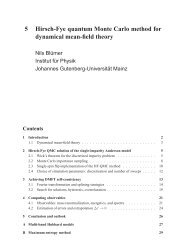Hubbard Model for Asymmetric Ultracold Fermionic ... - KOMET 337
Hubbard Model for Asymmetric Ultracold Fermionic ... - KOMET 337
Hubbard Model for Asymmetric Ultracold Fermionic ... - KOMET 337
You also want an ePaper? Increase the reach of your titles
YUMPU automatically turns print PDFs into web optimized ePapers that Google loves.
54 CHAPTER 5. STRONG COUPLING LIMITand the Pauli matrices:( ) 0 1σ 1 =1 0; σ 2 =( 0 i−i 0); σ 3 =( 1 00 −1), (5.56)so that we can write the single-site spin-operators ( = 1) as:S i,ν = 1 2 d† i · σ ν · d i; ν ∈ {1,2,3} , (5.57)where ν denotes the spatial component of S i . With the help of these tools we can rewrite oursecond order contributions as:H t2,2 = (t 2 ↑ + t2 ↓{S )∑ i,3 S j,3 − 1 }4 (d† i · d i )(d† j · d j ) (5.58)(ij)H t2,6∑}= 2t ↑ t ↓{S i,1 S j,1 + S i,2 S j,2(ij)(5.59)by using that spin-flip terms may be expressed by linear combinations of S i,1 and S i,2 :where S i,± are the spin-raising/lowering operators.S i,± = S i,1 ± iS i,2 , (5.60)The term (d † i · d i )(d† j · d j) can be neglegted, since at one fermion per site it is a constantand hence physically inactive. In hypercubic lattices it reduces to:∑(d † i · d i )(d† j · d j) = 2dN , (5.61)(ij)where d is the dimensionality and N is the total number of lattice sites. Finally we are ableto write the effective Hamiltonian as:H = H U + 1 U{H t2,2 + H t2,6}= 4t ↑t ↓U∑〈ij〉S i · S j + 2(t ↑ − t ↓ ) 2U∑S i3 S j3 , (5.62)since H U gives no contribution because of the absence of doubly occupied states. Note thatin this notation each bond contributes only once in contrast to the“(ij)”-notation. As we see,we have derived a antiferromagnetic H XXZ model with the constraint J Z ≥ J X . The model isable to reproduce the correct isotropic <strong>Hubbard</strong> model limit (t ↑ = t ↓ ) and the Falicov-Kimballlimit (t ↑ = 0, t ↓ > 0 or t ↑ > 0, t ↓ = 0). In the first case we obtain an isotropic Heisenbergmodel:H Hub → 4t2 ∑S i · S j (5.63)Uand in the second case we obtain an Ising model:H Fal → 2t2U〈ij〉〈ij〉∑S i,3 S j,3 . (5.64)In one dimension these effective models correspond to the results presented in [35].〈ij〉













